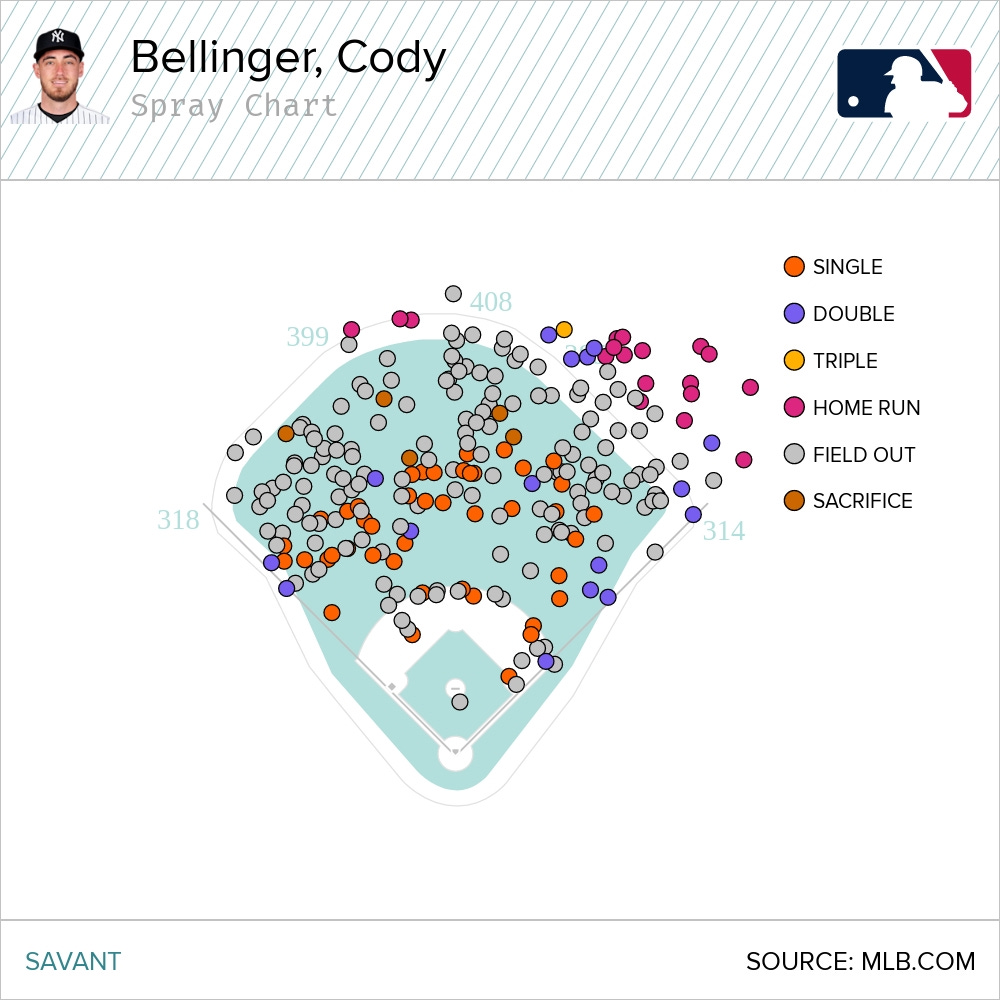Cody Bellinger's Outlook
He bounced back in Chicago, but there are some underlying concerns (or room for improvement!)
How do the Yankees answer for the loss of Juan Soto? By acquiring a former league MVP winner, of course. Soto’s never won one of those (…yet). Cody Bellinger, the newest Yankee, took home that honor in 2019 with the Dodgers. So, the Yankees just got better, amirite? OK, OK, I’ll stop. I’m not delusional. I’m well aware that Bellinger isn’t in Soto’s stratosphere, in case I need to make that clear. Nonetheless, it’s easy to dream on Bellinger improving in his move from Chicago to The Bronx.
You’ve likely heard by now that Bellinger’s lefty swing is a good fit for Yankee Stadium. He’s a pull hitter, and near the top of the league in pulled fly ball rate (87th and 89th percentile in 2023 and 2024, respectively). Lefties who pull the ball in the air tend to fare quite well with Yankee Stadium’s short porch. And yet, Steamer projects a 112 wRC+, which is a hair better than his 2024 results (109 wRC+). That projection feels a tad underwhelming, no? And yes, that projection accounts for the new home ballpark.
Bellinger undoubtedly will sneak in a few extra cheap homers thanks to Yankee Stadium. That, apparently, is not enough to significantly improve his outlook. Why? Two things: contact quality and approach.
Contact Quality
Before the pandemic, Clay’s son crushed the ball. Exit velocity, barrel rate, hard hit rate, you name it: Bellinger was near the top of the league. Then, in the COVID-shortened 2020 season, he started to barrel the bell less frequently. Later, in the playoffs, he dislocated his shoulder and needed offseason surgery. He was a shell of himself in 2021 and 2022, ultimately leading to LA non-tendering him. Blame the shoulder, perhaps.
In 2023, his first season with the Cubs, Bellinger still displayed poor contact quality. Despite that, he posted an excellent 136 wRC+, certainly fueled by some good fortune (.370 wOBA vs. .327 xwOBA). Bellinger remained lucky in 2024 when comparing wOBA to xwOBA (.322 vs. .301), albeit not as much as the year prior.
The Chicago boost seems to be a result of striking out a lot loss often. Going from a 27 percent K-rate in his last two years with LA to a 17 percent clip with the Cubs can make a world of difference, even without improving batted ball quality.
As long as his contact quality remains so, going from Wrigley Field to Yankee Stadium can only help so much. More homers will come from the ballpark fit, but we’re not about to see a spike to, say, 35 long balls without either an increase to pulled fly ball rate (it’s already really high, so probably not), or, an increase in exit velocities, hard contact, and barrels (ehh).
Approach
Perhaps realizing that his power wasn’t going to come back, Belling started making more contact, especially against pitches in the strike zone. He also took more strikes, for what that’s worth. In other words, when he was swinging at something in the zone, he was pretty damn sure he was going to put the ball in play.
Fewer strikeouts is a good thing though, right? Not necessarily, at least in this instance. Simply put, Bellinger does not make very good swing decisions. He’s too passive on pitches in the zone and still chases too often.

The data is pretty clear: Bellinger is below average in terms of overall selectivity (essentially the frequency of “good takes”) and swinging at hittable pitches. From a visual standpoint, you can get a sense of the same below.
Final thoughts
I understand why it’s difficult for a projection system to be bullish on Bellinger, even after moving to a more favorable home field. As long as he makes lackluster contact and is overly passive on heart of the zone pitches, it’s hard to expect any improvement outside of park factors.
I can’t help but wonder if the shoulder injury in 2020 permanently affected Bellinger. We don’t have publicly available bat speed data for years prior to 2024, but what we do know is that he was in the 13th percentile of swing speed this year. I would guess that took much harder swings at the beginning of his career. Now, perhaps he is hesitant to cut loose. And in turn, a longer swing theoretically could lead to a worsened approach because swing decisions need to be made sooner.
Maybe the Yankees’ coaching staff can help Bellinger improve. More aggression vs. pitches in the zone should help, provided that he can maintain strong pulled fly ball rates.
All told, even if all of the underlying inputs remain steady, Bellinger is a good fit. It would be great if he did more damage on contact, but as long as he keeps pulling the ball to right field, he’ll succeed. The Yankees need a lot of above average hitters to solidify the lineup, and Bellinger is just that.




